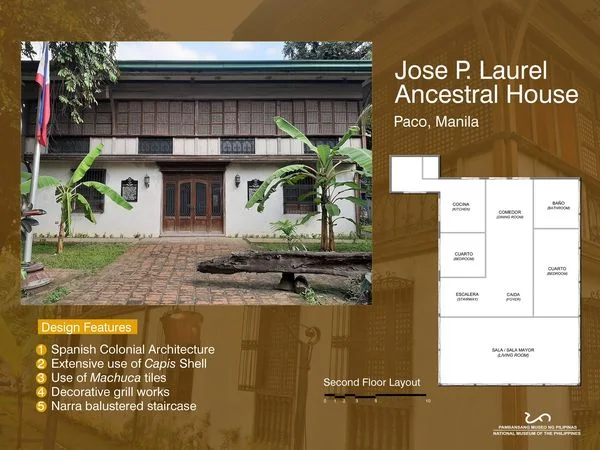Bahay na Bato in Paco, Manila | Jose P. Laurel Ancestral House
Dr. Jose P. Laurel, was the Philippine President of the Second Republic (1943-1945), and the only President to have served in all three branches of the Government. In 1926, during his time as a Senator, he purchased a bahay na bato house in Paco, Manila for his family. It served as their residence for 29 years from 1926 to 1955 before he moved to his retirement home in Mandaluyong.
The property was built in 1864 by a Spanish Count and survived the Philippine Revolution and the Philippine-American War as well as the three strong earthquakes in July 1880 that seriously damaged many structures in Manila. The house eventually became a landmark known as Villa Peñafrancia, named after the adjacent street of Peñafrancia.
The ancestral house has restricted stone walls on the ground floor, wooden floor and walls on the upper floor, and a roof made from galvanized iron sheets. It has a rectangular plan in floral style wherein the volada, now an open gallery makes the room spacious. Its façade is 14-meters wide while its longitudinal dimension is about 20-meters.
The piso bajo or ground floor is made of adobe foundation and plastered adobe walls with Machuca floor tiles. The ground floor has been reconfigured to suit the lifestyle of the Laurel Family with areas such as oficina (office), cuarto (bedrooms) and baño (bathroom). The piso alto or second floor has wooden floors and walls. The second floor was used as the living quarters where the sala mayor (main living room), cocina (kitchen), comedor (dining room), cuarto (bedrooms) and baño (bathrooms) are located.
Sliding wooden-framed capis shell windows are found in the entire house and has been its distinctive feature. The ventanillas and windows are secured by decorative grille works. Solid hardwood door panels are found on the ancestral house while the narra balustered staircase accentuated the ground and second floor. A two-paneled back door located on the north opens up to the courtyard which was used as a carport during Laurel’s time. An escalera (stairway) leads to the azotea or the open-air balcony beside the kitchen on the second floor.
The bahay na bato flaunts the capis shell sliding windows on the entire second floor with sizes that vary for each area. The window panels typically have three divisions. The sets of windows used in the living room and bedroom are composed of six sliding panels. The capis shells used were 40 to 45 millimeters in size and categorized as fourth flat or simple fourths which are shells that are less than 60 mm. An estimated total of 14,273 capis pieces were used for the ancestral house.
When the ancestral house underwent restoration from 1994 - 1995, the damaged capis shells were replaced with the same indigenous material bought from existing local producers. These were secured with new sturdy wooden frames. Sliding rollers were also installed to the window frames substituting the old tongue and groove mechanism.
The ancestral house serves as a legacy of President Jose P. Laurel’s memory and an example of the built tradition in bahay na bato architecture of the Spanish colonial period. The house exemplifies the distinctive and impressive use of the indigenous capis shells.
The Jose P. Laurel Ancestral House is currently featured as one of Manila’s Built Heritage Structures in the National Museum of Philippines’ interdisciplinary exhibition, Placuna placenta: Capis Shells and Windows to Indigenous Artistry.
When the museum doors open to the public once again, we warmly invite you to visit the exhibition located at Gallery XX, third level of the National Museum of Fine Arts. In the meantime, here is a glimpse to that exhibition:
Placuna placenta: Capis Shells and Windows to Indigenous Artistry
_______________
Credits:
Text and Illustrations by Ar. Kamille Patrizia C. Sepidoza-Daysa
Photos by Erick Estonante
© National Museum of the Philippines (2021)






No comments:
Got Something to Say? Thoughts? Additional Information?